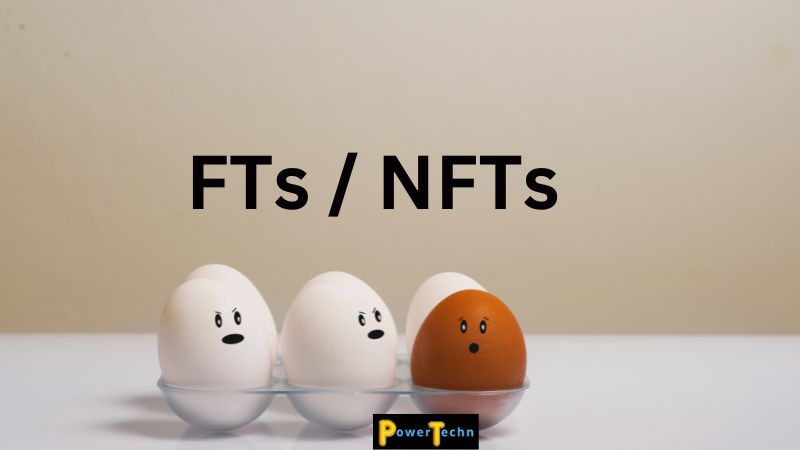In this article, you will learn the difference between Fungible Tokens and Non-Fungible Tokens. And, to know more about Cryptocurrencies and NFTs, click here.
The blockchain represents a single global archive, decentralized and potentially accessible to all, where transactions of digital assets are recorded, whether they are cryptocurrencies, collectible works, video games, music, or other generally called “tokens”. Based on how the information relating to these assets is stored, a distinction is made between fungible and non-fungible tokens.
In other words, tokens are a set of digital information within a blockchain that confer a property right to a specific subject and are endowed with a value established by the issuing company.
What Is A Token?
To start with the difference between Fungible Tokens and Non-Fungible Tokens, let’s, first of all, define what a token is.
A token can be defined as “digital information, recorded on a distributed register, uniquely associated with one and only one specific use of a system and representative of some form of right such as; the ownership of an asset, access to a service, receiving payment, and so on “.
According to some principles, tokens can be considered goods. But not all tokens are the same.
What Are Fungible Tokens?
All we want to know is the difference between Fungible Tokens and Non-Fungible Tokens. We have defined what a Token is, now, it’s time to define what Fungible Tokens are.
Tokens are defined as fungible if they are equal to each other. To be considered fungible, an asset must belong to the same category such as wheat, oil, and money. A $10 note has exactly the same value as another similar note.
Similarly, the value of one Bitcoin is identical to that of another Bitcoin, although it fluctuates over time. In general, therefore, all cryptocurrencies are fungible tokens since they have the aim of functioning as a medium of exchange.
Fungible assets such as money, shares, and gold bars are also called liquid because they allow you to easily carry out commercial transactions.
However, not all fungible assets are liquid: for example, a share of a company not listed on the stock exchange is fungible but it could be difficult to find a buyer.
When Is An Asset Fungible?
Keeping with the initial question of what is the difference between Fungible Tokens and Non-Fungible Tokens, let’s understand when an asset is said to be Fungible.
In general, an asset is fungible if:
- it contains a defined and measurable intrinsic value;
- it can be easily replaced with an asset with similar characteristics on the market;
- it can become a valuable asset in the long term.

What Are Non-Fungible Tokens
Now, having defined what a token and fungible tokens are, let us move straight to what Non-Fungible Tokens are.
Unlike fungible goods, non-fungible ones have the characteristic of being unique, non-replaceable, non-repeatable, and non-divisible.
Among the non-fungible goods, we can include paintings, musical events, contracts for the sale of a car, and in general goods or services with unique and unrepeatable qualities: since there is only an original, that good has a distinctive property that does not allow an exchange with something similar.
In English, non-fungible assets are called Non-Fungible Tokens (whose acronym is NFT).
NFT is defined as a digital certificate based on blockchain technology and in particular on the Ethereum blockchain and can be bought and sold online using various currencies. These are therefore assets belonging to the real world that also live on the blockchain.
Relationship Between NFT And Underlying Asset
In practice, NFTs are units of data stored on blockchains that certify the uniqueness of underlying digital assets, of which they constitute the representation in the digital ecosystem.
Non-fungible tokens, therefore, create an indelible and interdependent link between blockchain and the physical world.
However, by purchasing an NFT you do not get ownership of the asset itself, but a certificate (token) that ensures its authenticity and allows the owner to exercise rights over that asset.
Types Of Tokens
In addition to the distinction between Fungible Tokens and Non-Fungible Tokens, it is possible to catalog tokens in different types based on their use:
- Payment: They represent a means of payment (they are stablecoins such as Tether or USD Coin, classified as fungible assets)
- Commodity: Fungible tokens backed by commodities. An example is Pax Gold or Tether Gold, both of which are backed by physical gold.
- Utilities: They represent fungible tokens that can be spent in a digital ecosystem to access a product or service. One example is Bat (Basic Attention Token), built on the Ethereum blockchain and used by digital marketers to pay for advertisements.
Difference Between Fungible Tokens And Non-Fungible Tokens – Conclusion
As mentioned above, the main difference between Fungible Tokens and Non-Fungible Tokens is that NFTs are unique and irreplaceable while Fungible tokens can be replaced with another token of the same value.
Hope you enjoy this small post. Comment your views below.
You Can Also Read:
